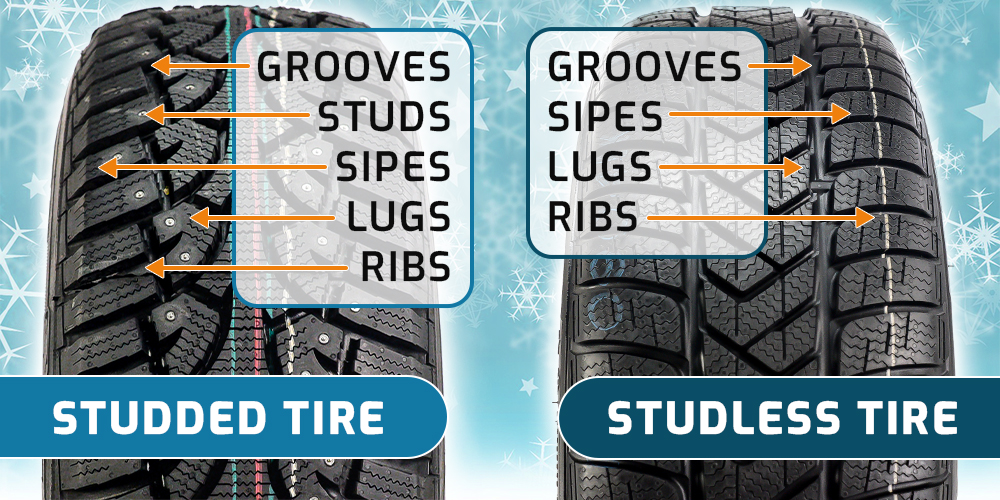As I sit here, sipping my hot cocoa and watching the snowflakes dance outside my window, I can’t help but think about the age-old debate that comes up every winter: studded or studless tires? It’s a question that’s plagued me for years, and I bet I’m not alone. So, grab a warm drink, settle in, and let’s dive into this frosty topic together!
TL;DR: Studded vs Studless Winter Tires
- Studded tires: Great on ice, especially near freezing temps. Noisy and can damage roads.
- Studless tires: Almost as good on ice, better on snow and clear roads. Quieter and more versatile.
- Choose based on:
- Your location’s typical winter conditions
- Local regulations on studded tires
- How often you encounter bare pavement
- Remember: Either option is way better than all-season tires for winter driving!
- Pro tip: Consider your driving style and budget too. Studless might save you some gas money.
- Bottom line: Pick the tire that keeps you safest in your specific winter conditions. When in doubt, chat with a local tire pro!
My Icy Adventure: A Wake-Up Call
Picture this: It’s a crisp winter morning, and I’m cruising down the highway, feeling invincible in my all-wheel-drive SUV. Suddenly, black ice! My heart races as the car starts to spin. In that moment, I realized something crucial – my choice of winter tires could mean the difference between a close call and a catastrophe.
That hair-raising experience sent me on a mission to unravel the great tire debate. Is the old-school studded tire still king of the ice, or have those fancy new studless options finally caught up? Buckle up, folks – we’re about to find out!
The Cold, Hard Facts: Studded vs Studless Performance
Ice Traction: The Ultimate Test
Let’s face it, when it comes to winter driving, ice is the boogeyman we all fear. So, how do our contenders stack up?
Studded Tires:
- These bad boys have been around forever, and for good reason. Those little metal studs bite into ice like a set of winter cleats.
- On wet ice near the freezing point (32°F/0°C), studded tires still reign supreme. They’re like the grizzled old-timer who’s seen it all and knows how to handle the slickest situations.
Studless Tires:
- The new kids on the block have come a long way, baby! Advanced rubber compounds and tread designs have narrowed the gap significantly.
- As temperatures drop well below freezing, some studless tires can actually outperform their studded cousins. Who would’ve thought?
Snow Performance: A More Level Playing Field
When it comes to the fluffy white stuff, the difference isn’t as dramatic:
- Both tire types crush it in snow conditions. It’s like watching two Olympic athletes compete – they’re both incredible, just in slightly different ways.
- Some tests show studless tires actually outperforming studded options in snow. Color me surprised!
The Science Behind the Grip: Winter Tire Technology
Studless Tire Wizardry
I’ll admit, I was skeptical at first. How could a tire without metal studs possibly compete on ice? But the tech behind modern studless tires is mind-blowing:
- Flexible rubber compounds: These tires stay soft and pliable even when it’s colder than a polar bear’s toenails outside.
- Deep tread depths: More grooves mean more snow-munching action.
- Siping technology: Tiny slits in the tread blocks create thousands of biting edges. It’s like giving your tire a mouthful of shark teeth!
Stud Evolution: Not Your Grandpa’s Tire Spikes
Studded tires haven’t been sitting on their laurels either:
- Lighter weight studs mean less damage to our poor, battered roads.
- Some clever designs spread the studs across the tread face for better overall grip. It’s like giving your tire an icy kung-fu grip!
Real-World Considerations: Beyond the Test Track
Road Conditions: A Mixed Bag
Here’s where things get tricky. Unless you live in the Arctic, chances are you’ll encounter a variety of road conditions throughout winter:
- Studded tires can be a menace on bare pavement. They’re like that friend who’s great at parties but a bit of a disaster in everyday life. Many areas restrict or ban them during non-winter months.
- Studless tires are the social butterflies of the winter tire world. They play nice with bare pavement, wet roads, and everything in between.
The Noise Factor: Hear Me Roar (or Not)
If you’ve ever driven behind a car with studded tires, you know that distinctive sound:
- Studded tires are LOUD on clear roads. It’s like driving with a pair of tap dancers strapped to your wheels.
- Studless tires? Smooth operators. They’re practically whisper-quiet in comparison.
Versatility: Jack of All Trades
For those of us who don’t live in a permanent winter wonderland, adaptability is key:
- Studless tires shine in areas with fluctuating temperatures or frequent clear roads. They’re like that friend who’s always prepared, no matter what the day brings.
Fuel Efficiency: Every Drop Counts
In these days of sky-high gas prices, every little bit helps:
- Studded tires can increase fuel consumption by about 1.2% on bare roads. It might not sound like much, but it adds up!
Safety First: Performance When It Matters Most
Braking: The Moment of Truth
When it comes to stopping on a dime (or a patch of ice), here’s the scoop:
- Some tests show studded tires stopping 15% shorter on ice. That’s the difference between a close call and a fender bender!
- But plot twist – other tests have shown some studless tires (looking at you, Blizzaks) outperforming studded options in braking on both packed snow and ice. Color me impressed!
Longevity: The Long Game
Winter tires are an investment, so how do they hold up over time?
- Studded tires might lose some of their mojo as the studs wear down. It’s like watching a prizefighter past their prime – still tough, but not quite as sharp.
- Studless tires can start to lose their edge after a couple of seasons as that soft, grippy rubber wears away. But with proper care, they can still put up a good fight!
Making the Choice: What’s Right for You?
After all this research, my head was spinning faster than my car on that patch of black ice. But here’s what it boils down to:
- Where do you live? If you’re in an area with lots of ice and strict winter tire regulations, studded might be the way to go.
- What’s your driving style? Leadfoot on the highway or cautious crawler? Be honest with yourself!
- What’s your budget? Don’t forget to factor in potential fuel efficiency and longevity.
- How’s your patience level? Remember, studded tires often need to come off in the spring. Are you up for the seasonal changeover?
My Personal Verdict (and a Call to Action!)
After my deep dive into the world of winter tires, I’ve personally decided to go studless. The versatility, quieter ride, and impressive technological advancements won me over. But here’s the thing – your mileage may vary (pun intended)!
The most important thing is that you’re thinking about winter tire safety. Whether you choose studded, studless, or are still on the fence, being prepared for winter driving is crucial.
So, here’s my challenge to you: Take a good, hard look at your current winter tire situation. Are you confident in your traction when the weather turns nasty? If not, it might be time for an upgrade.
Remember, the best winter tire is the one that keeps you safe on your specific roads, in your specific conditions. Do your research, talk to local tire experts, and maybe even consider taking a winter driving course to sharpen your skills.
Stay safe out there, and may your winter drives be smooth and slip-free!


